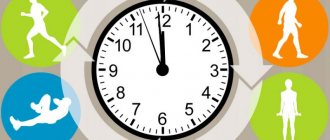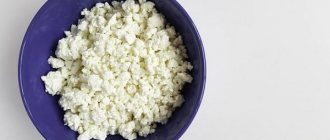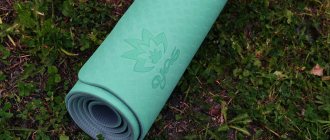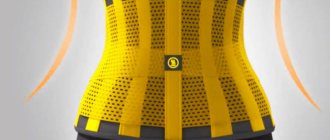The main rule of training for teenagers is to develop the habit of training regularly. It takes at least 28 days to develop a love for sports. People who exercise regularly for more than one month are more likely to maintain the habit¹.
The benefits of sports for teenagers include both muscle development and strengthening of the skeletal system. Exercises with body weight are especially important - they help create an athletic posture without overloading the spine. A set of simple exercises for beginners is in the material below.
Why is fitness necessary for a teenager?
It is believed that fitness helps in two cases: losing excess weight and strengthening the muscle corset. But for children, harmonious physical development, which is ensured by regular sports, is more important. At the age of 10-15 years, children experience a stage of rapid development, as a result of which all body systems undergo dramatic changes. Especially the skeleton of a child. During this period, bones grow faster than muscles, so the teenager looks angular and awkward.
The cardiovascular system also changes. Due to a sedentary lifestyle, most children develop physical inactivity, increasing the risk of spinal curvature and other health problems. The psychological factor is also important. Teenagers are rarely satisfied with their appearance, which is why complexes and embarrassment appear. Fitness will help correct the situation. And in the future, regular exercise will create a beautiful figure and protect you from excess weight.
Design and modeling circles
All children have a love for assembling houses and pyramids. Therefore, the list of clubs and sections for teenagers that develop this talent is very large. There are paper design classes where children learn that paper can very well take different shapes. For older children there are courses on modeling complex shapes. These could be airplanes, cars, buildings or entire parks. Here children learn the basics of composition and gain their first design skills. Such a circle will be useful for inquisitive children who want to understand how this or that mechanism works, and also those children who cannot live without the desire to break something should go here. When you see how a thing is created, the desire to destroy instantly disappears.
At what age can you do fitness?
If previously playing sports was the privilege of adults, now children’s and teenagers’ fitness is a fashionable trend. In the gym, children can do yoga, Pilates, strength training in a group or with a trainer. Moreover, individual lessons are recommended up to 14 years of age, because from this age a teenager can attend classes on an equal basis with adults.
From the age of 16, a child can begin independent training. However, it is worth remembering that at this age the skeletal system is strengthening, so intense strength training can lead to delayed development or injury. Due attention from parents will help avoid this. In return, your child will receive a lot of benefits from regular exercise:
- Increased flexibility and endurance.
- Improved coordination.
- Strengthening tendons and ligaments.
- Prevention of cardiovascular diseases and ARVI.
- Increased self-esteem.
- Positive attitude and development of healthy lifestyle habits.
The main thing is that fitness brings pleasure, and exercises are not a burden. Therefore, it is important to choose the right type of physical activity, focusing on the child’s preferences, his state of health and body type.
Acting classes
All children love to make faces and fool around. But you shouldn't blame them for it. It is better to channel this irrepressible energy in the right direction. For this purpose, children's clubs and acting sections were created. Here, children are offered not only to act in theatrical productions, but are also taught singing lessons, forced to do physical exercises of varying difficulty, and in some studios they even practice making their own costumes. Children like this kind of creative process, where no one scolds for deviating from the script and light improvisation. In this circle, children learn not to have stage fright, and, as a result, they will not have the fear of public speaking.
And here you can acquire the skill of managing your emotions and your facial expressions. Also, children working on stage are better able to listen to their parents and peers because they are taught to be more attentive to their opponents.
What type of fitness to choose and why
When choosing the type of training for a teenager, you should focus on the purpose of the lesson. If sport becomes a career in the future, then you should listen more carefully to the advice of your doctor and coach. In this case, it is necessary to take into account the child’s physique, health status and temperament type. However, if fitness is a way for you to increase your teenager’s activity, instill healthy habits and improve immunity, then the choice is up to the teenager. And there is plenty to choose from:
- Swimming strengthens the back muscles, develops the respiratory and cardiovascular systems.
- Dancing, thanks to the gentle load on the body, develops endurance and flexibility, and contributes to the formation of correct posture.
- Football, basketball or volleyball are suitable for boys. They provide good physical fitness and mood;
- A skateboard, roller skates or skates are useful and modern, especially if you master complex tricks.
- Although strength training is less beneficial for a teenager, with adequate load it helps strengthen muscles and ligaments. You can start with a barbell, dumbbells or small weights.
- Pilates, calanetics and yoga are classes for advanced teenagers who want to develop flexibility and learn to listen to their body and live in harmony with themselves. Basic asanas are easy to learn from videos.
- Cardio training is the most accessible form of fitness. Running, race walking, cycling or exercise on an orbit track do not require the supervision of a trainer. You can't make a mistake when doing them.
As you begin the habit, try to explain to your teen that it is necessary to stay fit and healthy. It also makes sense to give an example of what sport your child’s idol plays in order to motivate him to practice.
The influence of sports on teenagers
The positive importance of sports in the lives of teenagers is enormous. When playing sports, a teenager:
- develops faster
- better oriented in space
- getting stronger
- feels better about his own body
- gets sick less
- becomes more emotionally stable.
Let's look at everything in order.
- Strengthening your health. By engaging in physical activity, a teenager first of all improves his health. Oxygen and blood circulate better in all body systems and organs. All muscles of the body are trained regularly and function perfectly. The most ordinary morning exercises will be useful, as it will tone the entire body. Playing sports allows a teenager to become more resilient, and this is very important in the modern rhythm of life.
- We build character and willpower. Sport shapes the strong-willed character of a teenager, changing him for the better. Will develops, the desire to win, endurance, the ability to overcome obstacles, and not be afraid of defeat. Willpower, formed in the process of sports activities, can overcome all negative habits and traits, and also create a strong personality out of a teenager, capable of achieving a lot.
- We set ourselves up for success. Please note that almost all famous people who have achieved great success played sports in childhood, and continue to do so to this day. Sport and success are interconnected concepts. If a teenager wants to learn how to set goals and achieve them, sports will teach this. In addition, playing sports makes it possible to get everything you need from life, even if there are no hopes or opportunities.
- We discipline. Teenagers who play sports are more focused and disciplined. And these are important qualities for achieving success in school and other areas of life. And they will definitely come in handy in adult life.
- We create the right leisure time. Parents will not deny that, having accustomed their child to sports, he will not be drawn into bad company, and he will not want to wander idly on the streets in search of adventure. Young athletes usually have many friends with whom he will enjoy communicating.
What you need to know before starting classes
Any type of fitness immerses a teenager in “adult” emotions, taking up part of his free time. Therefore, you should prepare for such a step. Eg:
- When enrolling a teenager in a fitness club, do not force your opinion on him. Instead, it is better to recommend a section to him, and the choice should be his.
- Consult a physician if your child has a chronic illness.
- Buy beautiful and comfortable sportswear and sneakers. Moreover, for girls, this approach will be an additional incentive not to miss classes.
- If a teenager needs to lose weight, then exercise should be accompanied by dietary control from parents.
- Buy a family membership and go to the gym together. Your personal example will become an additional incentive and pride for the child.
If a teenager decides to quit classes, consult with a coach to clarify the situation. Maybe it’s just fatigue that you need to endure by taking a break for a week, or it’s “burnout”, and the time has come to change the type of activity.
Dance clubs
Many parents try to realize themselves through their children. That’s why dance clubs and sections for teenagers are in such demand. Parents believe that their child simply must be able to dance a waltz, tango, or at least achieve success in driving a round dance. Thanks to such attacks from the older generation, many children simply hate dancing for the rest of their lives. But willy-nilly they still have to attend clubs. So what types of dance sections exist? This:
- Folk dancing - the youngest dancers are usually enrolled here. They enjoy dancing in circles and tap dancing. The main advantage of this type of dance: a girl does not always need a partner.
- Ballet is a very beautiful, but also incredibly complex form of dance. Girls of any size can attend classes, but only the most capable craftswomen will perform on stage. That is why ballet classes give rise to many quarrels and slander between dancers.
- Ballroom dancing is a combination of classical ballet with modern choreography. To be able to perform on stage, a girl needs to find a partner, and this can sometimes be very difficult to do.
- Modern dancing - children usually go to such classes with pleasure and of their own free will. After all, in order to amaze your classmates at a disco, the skill of such dances is simply necessary.
What exercises can you do?
It is recommended that teenagers perform strength exercises only with their own weight, as additional load can slow down bone growth. The simplest exercises include:
- Knee push-ups are an easier version of classic push-ups. In this version, the load falls on the knees, and the shins need to be raised and the toes extended. This exercise strengthens the pectoral muscles and arms. Fast execution forms the relief, slow execution creates a toned appearance.
- “Plank” is a static exercise, during which it is important to hold the body correctly. To assume the position, lie on the floor with your stomach down, bend your elbows at right angles and go into a lying position. The “plank” uses more than just your abdominal muscles, so after 30 seconds in this position you will feel trembling throughout your body.
- Lunges are an effective exercise for working the thighs and buttocks. Place your legs parallel to each other, straighten your back and tuck your stomach. Maintaining this position, take a long step forward, bending your knee and placing your weight on your extended leg. Return to the starting position.
What clubs can a child with ASD and cerebral palsy attend?
Of course, such disorders are not the same as poor vision or hearing. Therefore, there is no point in organizing club sections for hearing-impaired teenagers, but clubs for children with ASD and cerebral palsy need to be created. Unique children should also have the opportunity to express themselves creatively. But the development of such teenagers requires special attention, because it is better not to leave them alone with each other. Children with ASD and cerebral palsy can go to drawing, design, swimming and horse riding.
Examples of training plans by day
Systematic exercises at home can be no less effective than training in the gym. Let's look at an example program that uses all major muscle groups. Let's start with a warm-up:
- First of all, five to seven minutes of light jogging or walking.
- Now we stop, feet still shoulder-width apart, arms along the body. Slowly turn your head completely to the left, then to the right. Repeat 6 times in each direction.
- Place your fingers on your shoulders and spread your elbows to the sides. Make rotational movements outward and inward 10-15 times.
Having completed the warm-up, we proceed to the main exercises:
- Let's start with squats. You need to squat down 10-15 times until parallel to the floor, this will help avoid additional stress on the joints. In this case, the back should remain straight, feet shoulder-width apart, and hands on the belt or in front of you.
- Next comes the traditional pull-up on the bar. 5-10 times will be enough. The correct technique for performing pull-ups can be seen in this video (https://www.youtube.com/watch?v=eMsTT1uajTY).
- 10-15 push-ups with your body as straight as possible and as low as possible. Without following the technique, exercises are meaningless.
- The next exercise is “bicycle”. Lie on your back, arms along your body. Raise your knees bent so that you form a right angle with your body. Rotate your legs 30-40 times, simulating pedaling a bicycle.
You need to complete the complex with stretching:
- Get on all fours on the mat and bend your back down and up ten times.
- Then sit on the floor and spread your legs as wide as possible without straightening them. Take turns leaning left, right and forward. Repeat 10 times.
- Lie on your back and bend your knees. Then slowly raise and lower your pelvis 10 times, holding it for ten seconds in the upper position.
At this point the exercises are over - you can catch your breath and return to your business.
Activities for children with hearing and vision problems
Experts advise not to divide children into groups, into normal and those with defects. All guys are unique, and none of them should feel disabled. Clubs and sections for teenagers in Moscow help children socialize better. No one will laugh at a child with poor eyesight at school if there are more than 5 such children in the class. The same situation is with clubs. There is no point in taking your child to some special sections so that he gets more attention there. Unfortunately, many children now have poor vision and hearing. Of course, these shortcomings need to be treated, but there is no point in focusing attention on them. Clubs and sections for teenagers with hearing and vision problems can be varied: swimming, wrestling, tennis, drawing or acting.
Of course, you shouldn’t mock a child and send a girl with poor vision to embroider with beads, or a boy with poor hearing to a music club. Parents must adequately assess their child's abilities.
Common mistakes
Adolescence is a time for making mistakes and looking for your “rake”. However, some of them are easy to avoid, the main thing is to notice in time:
- Lack of proper diet.
- Ignorance of exercise technique.
- Irregularity of classes throughout the month.
- Lack of sleep.
- Insufficient break between fitness visits.
- Overload.
If a teenager decides to take classes seriously, it is worth drawing his attention in advance to possible difficulties and mistakes, explaining them in a positive way.
Singing and playing musical instruments group
The skill of playing the guitar or piano will definitely come in handy in adulthood. That is why children's clubs and sections that develop musical abilities are in great demand. Parents are not trying to make a second Mozart out of their child, they just want their child to be able to hear the rhythm and develop fine motor skills by plucking strings. In order for a child to feel his activities are necessary, it is necessary to at least periodically organize family concerts at home, where each of the children will demonstrate their talents to their parents.
How to eat healthy for a teenager
The typical “diet” of a teenager is far from the healthy nutrition needed by a growing body, especially when playing sports. For the correct balance of all nutrients, the body needs:
- Fruits and vegetables rich in vitamins and microelements.
- Dairy and fermented milk products, cheeses.
- Lean meat and fish, eggs.
- Legumes and nuts.
- Whole grain cereals as a source of healthy carbohydrates.
Calcium is essential for the development and strengthening of bones and teeth. It is found in hard cheeses, milk, lentils, beans, broccoli and nuts. Meat products, fish and cottage cheese are rich in protein, which is necessary for the restoration of muscle tissue. A diet rich in protein will help a teenager get stronger and cope with the load.
Fitness not only promotes muscle growth and puts the whole body in order. Regular attendance at classes is the key to a beautiful body and a successful and long life for the younger generation. That's all. If you liked it, subscribe to articles and share useful information on social networks. There will be a lot more interesting things!
The benefits of additional education
We found out what clubs and sections there are for teenagers. Now you need to understand what benefits they bring.
- Children learn to work in a team. And this is great, because at school each student is responsible for himself, and in circles there are often team activities. This way, children can form friendships and learn that it is possible to enjoy helping others.
- Ability to achieve set goals. This life trait is not given at birth, it is formed. Therefore, children should definitely be sent to the sports section, even if only for a short time.
- Creative self-expression is only possible through art. But you need to create according to generally accepted laws and canons. To get your first creative education, you definitely need to go to an art club.
- The ability to appreciate beauty is a skill that is developed by attending an art or music school.
- The desire to gain new knowledge is one of the main things in our lives. It will be much easier for a student to study if he enjoys his studies. This skill is developed by the modeling and design club.
What changes await the child?
Sport is good for more than just physical health. In addition to increasing endurance, increasing strength and other indicators, the boy’s personal qualities also change, which are influenced by various sports:
- Eastern martial arts help develop patience and learn restraint. The child will be able to choose the right tactics of behavior in different situations and learn to think logically. In addition, the reaction improves, self-confidence and flexibility appear.
- Team games will teach you to act together and help develop communication skills. They will be especially useful for a shy child who cannot easily find friends.
- Creative sports, such as dancing or rhythmic gymnastics, will influence the development of artistry and hone the sense of rhythm. The child's body will become more flexible and plastic.
- Winter sports activities will teach a child to go towards his goal, despite the difficulties. They build character and develop leadership qualities.
In addition to these qualities, the boy will become more disciplined, learn dedication and concentration.










